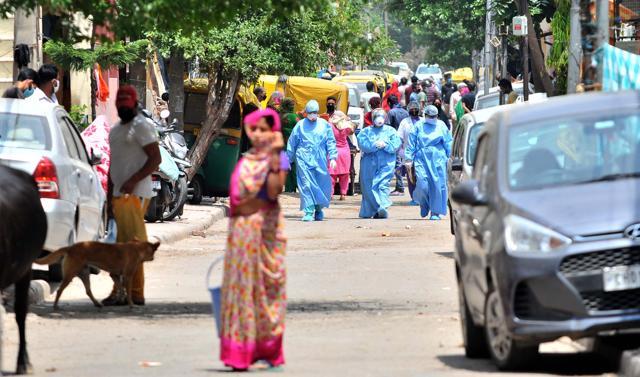Just 12 houses in Chandigarh’s Bapu Dham Colony account for three-fourths cases
People sneaking out of containment zone remains a challenge for authorities; 1,000 residents under home quarantine
The vulnerability of a congested area like city’s major Covid hotspot — Bapu Dham Colony — can be gauged from the fact that three-fourths (84) of 110 positive cases in the colony are from just 12 houses.

Figures obtained from UT’s official data reveal that the remaining one-fourth cases (26) are from another 16 houses. Among these, the highest number of cases from a single house is 18.
All these 28 houses are situated in four of the 20 pockets in the colony that has 2,500 multi-storey houses. These four pockets are completely sealed, and essentials are being provided to the families of those affected.
Apart from those infected, 1,000 residents are under quarantine, of whom 64 have been kept in institutional quarantine outside the colony.
Director health services Dr G Dewan said effective containment of the area was key to breaking the chain of infection. Yet, reports of people sneaking out of the area, despite claims of strict police enforcement and installation of CCTV cameras, continue to pose a challenge.
Seven residents of the colony, working at a meat shop in Sector 28, left the containment zone and moved on rent to Sector 29. Even as police booked them and sent them to the temporary Manimajra jail, they did manage to sneak out from the “high security” area.
Similarly, a man was found out and about in grain market, Sector 26, and was also arrested.
RTI activist RL Garg said while residents were at fault for flouting norms, laxity in enforcement had also come to the fore. “Such carelessness may cost the entire city dear,” he said.
Dr Rajesh Dhir, president of Chandigarh chapter of Indian Medical Association, said health teams had done well in screening all houses and sampling suspected cases, but residents should also cooperate and police should step up their efforts, completely seal outer boundaries of the area and guard these round-the-clock.

INTERNAL MOVEMENT ON UNABATED
Movement within the colony in unsealed areas also remains unchecked.
Area councillor Dalip Sharma said people were forced to head out for food or other necessities. “Even as the supply of essentials is erratic, there is a sizeable population with no resources to buy ration. Only a handful of people got free ration under the PDS scheme. Local authorities must distribute free ration among all households, so people don’t come out looking for food,” Sharma said.
This was the need of the hour, he said, as daily wagers here were mostly dependent on the nearby grain market, and with restrictions in place, all their income sources had dried up.
The councillor also raised concerns over the presence of a large number of labourers staying just outside the colony in the transport market.
He said many of them were willing to go back to their home states, so the administration should work the logistics out.
EVERY THIRD SAMPLE TURNING POSITIVE
Discovery of the Covid samples turning out positive cases is also on the higher side in Bapu Dham Colony.
The UT health department has collected 300 samples since detection of the first positive case on April 24. Of these, 110 people have been found infected, which means every third sample has become positive.





